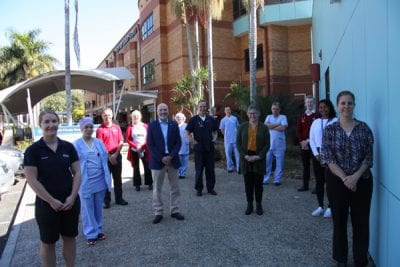
Members of TPCH’s Whole Lung Lavage team
TPCH is home to the innovative Whole Lung Lavage team which is saving the lives of young people with silicosis, a disease which mainly affects stonemasons. The recent silicosis epidemic in Australia, fuelled by the availability of imported artificial or engineered stone, has resulted in hundreds of workers developing the disease.
Particles from the stone penetrate the lungs which lead to difficulty breathing, fatigue, chest pain and shortness of breath. Until recently, there has been no treatment for the disease.
Since the beginning of 2020 the team at TPCH, led by Professor Dan Chambers, have been leading the way in silicosis treatment by performing a whole lung lavage. This procedure essentially flushes out the lungs in a three to four-hour operation to give them a good clean and rid them of toxic particles.
Prof Chambers said that whole lung lavage involves flushing one lung with 20-30 litres of saline, while ventilating the patient’s other lung.
The team conducted a substantial amount of lead up work in their laboratory to understand how silicosis leads to respiratory failure. They also developed world-first methods to measure the amount of silica in the lungs of affected workers.
“From the work we have done in our laboratory, we know that we can remove a significant amount of toxic silica and other material using this procedure. We are very hopeful that this will translate into much better clinical outcomes for this group of young men who would otherwise face death or lung transplantation,” Dan said.
“It is a procedure which requires a high degree of skill and a multidisciplinary team – don’t try this at home!”
Anaesthetist Dr Ivan Rapchuk said that even though it sounds fairly straight forward, there’s a lot that can go wrong in a procedure like this, so it’s important to be surrounded by people you trust and who aren’t afraid to speak up.
“Every team member needs to be confident in their role and responsibilities, and they also need to know how the other team members fit into the equation too,” Ivan said.
“It’s crucial that everyone in the room knows this procedure back to front and is comfortable speaking up if they feel something is not right. There’s nine of us in the room. An anaesthetist, an anaesthetic technician, a clinical perfusionist, three nurses and a respiratory doctor. If we can’t trust and respect each other, it is the patient who can pay the price.”
The team is growing the skillset of a number of clinicians at TPCH to spread the work among larger groups.
“I’m incredibly proud of the way our team has come together. What we have achieved is just another in a long line of innovations at The Prince Charles Hospital which have helped Queenslanders with severe lung and heart conditions who could not find help anywhere else,” Dan said.
“What I have seen in our research and clinical teams is a coming together of great science, great medicine, great clinical skill, great commitment and great compassion. It’s also about not being afraid to innovate.”